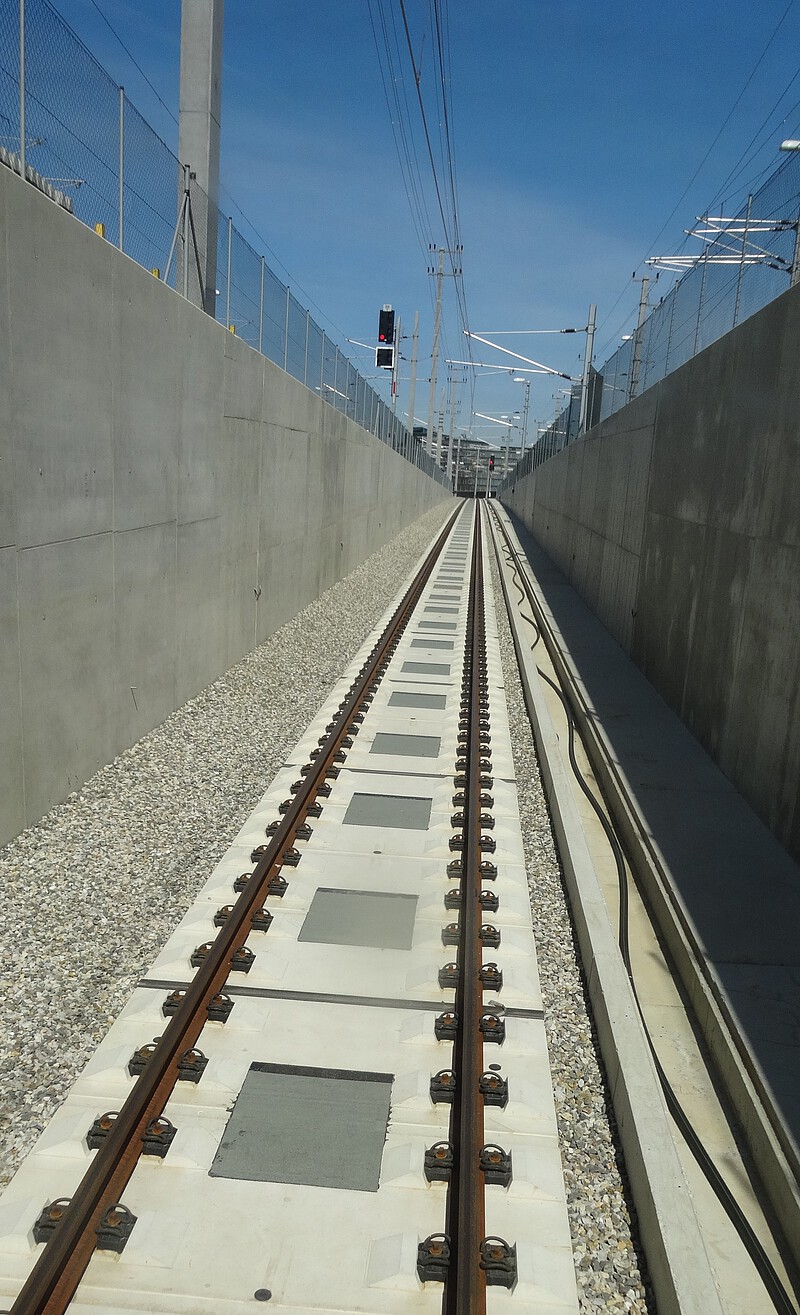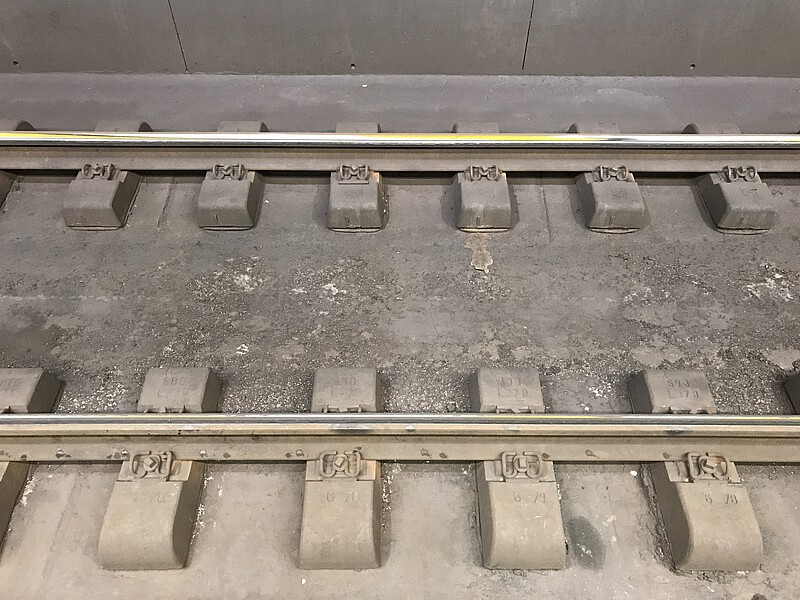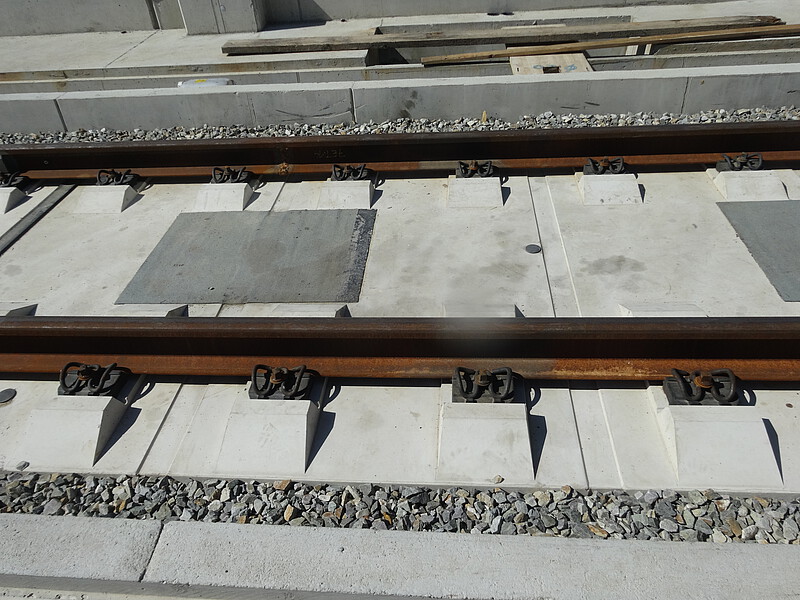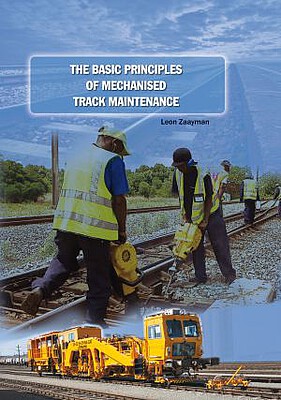Ballastless track
The demands on the track system have changed greatly since the start of railways. This applies not only to parameters such as axle load and speed, but also less obvious factors such as train length and frequency.
In addition to the classical design of track grid floating in ballast, other non-conventional designs have been developed with varying degrees of success. The railway permanent way has an average useful life of between 30 and 60 years. Because of the large financial investments that are necessary, innovations in the field of railway infrastructure only gain acceptance slowly. Therefore, it would be wrong to describe the sector as slow at implementing innovations. The numerous and different certification regulations, some of which are due to national specifications, make it difficult to introduce new products. Changes in the track have consequences for safety, which is why an in-depth examination of any new design is understandable. Current efforts at the European level aim to shorten the process, in order to facilitate the opportunities for innovation.
Ballast was originally chosen as a basis for the railway infrastructure due to its ready availability and good maintenance options. It is currently, however, this very component which limits the service life of the complete system. The replacement of the complete system was previously influenced by wear on the sleepers and rails, but now due to the increased useful life it is the ballast. It was only through the invention of the soled sleeper that the properties of the ballasted track could be significantly improved.
The negative impact of the ballast on the service life of the track led to initial designs of ballastless track. The ballast is replaced by sub-layers of concrete or asphalt which, unlike ballast, have no or only slight plastic deformation. The lack of elasticity of these layers is compensated by the conscious use of elastic components. Only in this way can the necessary deflection of the track and the resulting load distribution on multiple supporting points be achieved.
The use of ballastless track requires settlement free or low settlement subsoil. Inhomogeneous settlements of the selected support structure can be balanced only with difficulty or not at all. First tests with ballastless track were carried out by the DB in 1959 in Hengstenberger Tunnel and in Schönsteiner Tunnel. On the main line it was installed for the first time in 1967 in Hirschaid Station. The first applications, however, were not very successful. The fastening bolts failed in the tunnel areas due to corrosion and on the main line the negative consequences of subsidence in the subsoil were reflected in the system. Only 23 years after the installation in Hirschaid Station it had to be replaced again. Nevertheless due to its low maintenance requirement the system showed possible advantages compared with conventional ballasted track.[1]
In Japan, the tracks of the Shinkansen high speed lines are carried on piles. The resulting homogeneous subsoil is the best prerequisite for the continuous homogeneous support of the track grid of the ballastless track. Therefore it was decided, even after problems with the ballast track (Tokyo – Osaka), as a general rule to use the design of ballastless track.[1]
A prerequisite for the success of the ballastless track system is the low settlement of the foundation. Thanks to the targeted arrangement of elastic elements it is possible for the stiffness of the individual layers to be co-ordinated.[2]
The design of a ballastless track is generally made up of the following components:
- rail
- rail fastening
- sleeper
- concrete or asphalt base layer
- hydraulically bound base layer
- frost protection layer
- subsoil
Over the years, different types of ballastless track have been developed. In general, these can be divided in terms of their construction in Europe into two groups.[1]
Embedded design
In the embedded design a friction locked joint is created between the track grid and the track bed layer. In a first step, the track grid is fitted either in the classic manner over the individual sleepers or by prefabricated components. After the geometric alignment (often by spindles) and a possible pre-tensioning of the rail fastening systems, the background is filled with in-situ concrete.
Representative:
- RHEDA type
- Heitkamp type
- SBV type
- Züblin type
- SBB-Bözberg/Stedef type
- LVT type
Directly supported design
In the directly supported design there is no force-locking connection between the track grid and the track-bed layer. The vertical reference position of the track is produced through the track-bed layer. Here an elaborate spindle can thus be omitted. Directly supported designs are generally constructed with asphalt trackbed layers, on which the sleepers covered with the geotextile are laid. If the weight of the track grid does not stop it lifting when a train passes over it the sleepers must be vertically anchored. The ballast placed on the sleeper ends and in the sleeper cribs protects the track-bed layer against UV rays and heat and stabilises the horizontal track geometry.
Representative:
- SATO type
- ATD type
- BTD type
- Walter type
- GETRAC type
Support point bearings without sleepers
In this type of bearing there is no sleeper, and the rail is directly connected with the track bed layer made of concrete. Regarding the design, a distinction is made between:
- monolithic support on site
- use of prefabricated plates or frames
Representative:
- Rasengleis
- Hochtief/Schreck-Mieves/Longo type
- FFC type
- BES type
- BTE type
- Bögl type
- ÖBB-PORR type
Continuous support
The rail is set up without a rail fastening on a longitudinal beam in a dedicated space. The rail is then encapsulated in concrete many times and through the elastic elements stabilised in its position. Due to the large amount of cladding required this type is mainly used in sound and vibration-intensive areas.
Clamped rails are not used on the main line and, therefore, not discussed further in this chapter.
Advantages of ballastless track
- to a large extent maintenance free
- reduction of maintenance costs
- increase in the capacity
- no flying ballast at high speeds
- unrestricted use of the eddy current brake
Disadvantages of ballastless track
- high investment costs
- bad air noise properties
- risk of changes in the position of the track due to possible difficult correction process
- high weight
- high repair costs if there is derailment damage
You can find suitable specialist literature to the topic here:
The Basic Principles of Mechanised Track Maintenance
This book is dedicated to the many people involved in the day to day planning and performance of track maintenance activities. Providing a practical approach to everyday challenges in mechanised track maintenance, it is not just intended as a theoretical approach to the track system.
Railways aim at transporting people and freight safely, rapidly, regularly, comfortably and on time from one place to another. This book is directed to track infrastructure departments contributing to the above objective by ensuring the track infrastructure’s reliability, availability, maintainability and safety – denoted by the acronym RAMS. Regular, effective and affordable track maintenance enable RAMS to be achieved.
Best Practice in Track Maintenance, Vol 1 - Infrastructure Management
Infrastructure Management Volume 1 looks at aspects of infrastructure management with particular reference to the single European railway area. Based on best-practice examples from Central Europe, measures for the targeted retrofitting and improvement of the infrastructure maintenance of the existing network are presented. In many cases, infrastructure operators are faced with a generational change, which accelerates the process. Modern information and communication technology can simplify the comprehension and presentation of complex contexts. Modified approaches to asset management and life-cycle management enable implementation of the "transparent permanent way" or the "railway 4.0".
- [1] Darr, E.; Fiebig, W.: Feste Fahrbahn. Konstruktion und Bauarten für Eisenbahn und Straßenbahn. VDEI-Schriftenreihe. Eurailpress Tetzlaff-Hestra, Hamburg, 2006.
- [2] Freystein, H.; Muncke, M.; Schollmeier, P.: Handbuch Entwerfen von Bahnanlagen. Regelwerke, Planfeststellung, Bau, Betrieb, Instandhaltung. Eurailpress, Hamburg, 2015.






